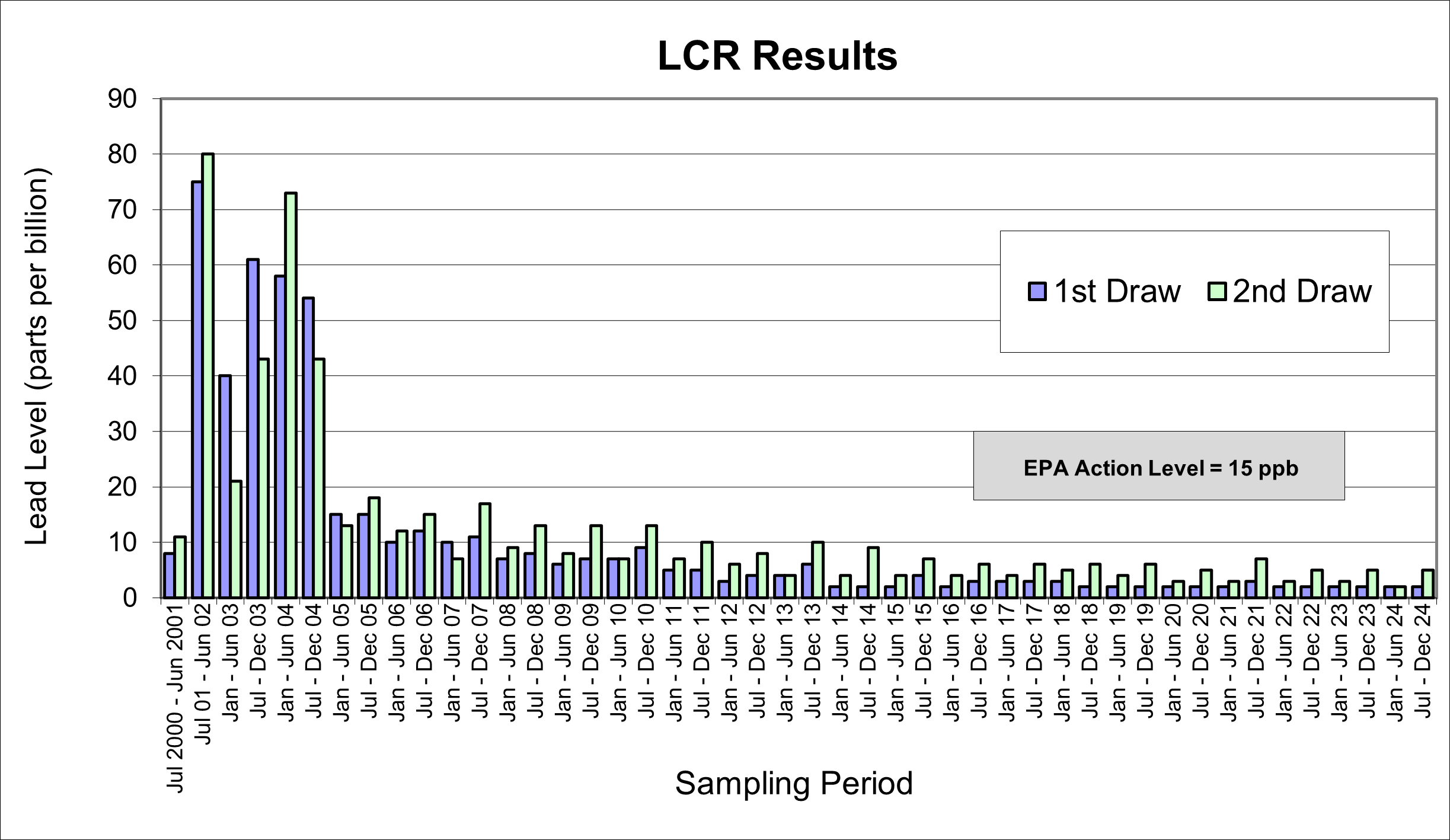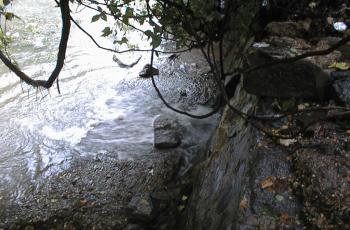When the water comes in contact with pipes, plumbing, and fixtures that contain lead, the lead can release into your drinking water. Lead sources and lead levels vary between buildings, so it is important to identify and remove lead sources in every household.
The EPA requires water utilities to test water samples collected from homes with lead and copper to ensure the water chemistry of our water is not causing significant corrosion of these metals in the water service line or internal home plumbing. The treatment plants for the District of Columbia both add orthophosphate to the water to minimize lead release into the water.
The graph below shows the lead results from both 1st and 2nd draw samples collected during DC Water’s EPA Lead and Copper Monitoring. The EPA limits for lead and copper are the 90th percentile of all 1st draw samples collected during a sampling period. This means that at least 90 percent of over 100 homes sampled in each 6-month monitoring period must be below the action levels set by EPA.
Customers may request a free lead test kit once per year from the Drinking Water Division. Please review our lead section for detailed information about lead in the District and how to minimize lead exposure.
LCR Lead Results
The EPA Lead Action Level (15 parts per billion (ppb)) is based on first draw samples.

LCR Individual Lead Sampling Results (2005 - Current)
The EPA Lead Action Level (15 parts per billion (ppb)) is based on first draw samples.
LCR sampling data represents individual household lead sampling results, as reported to EPA Region III.
*Important: Lead results for an individual home do not represent lead levels in households located on the same block. Lead levels vary from home to home and are dependent on lead sources between the water main and an individual household tap. Pipe materials vary substantially across the District, even among homes located on the same block. If you're interested in testing your drinking water for lead, contact the Drinking Water Division at 202-612-3440 or email leadtest@dcwater.com.
| Sample Site Address Block | Water Service Pipe Material | Sample Date | Lead Result 1st Draw (ppb)* | Lead Result 2nd Draw (ppb)* |
| Household lead sampling sites. Street name, block number and quadrant. | Material of the water service pipe during the sampling period. A "partial" lead service pipe is where a portion of the service pipe material is lead and a portion is non-lead | Day, month and year the samples were collected. | Measures lead release from household plumbing and fixtures, especially potential lead sources near the tap where the sample is collected. Parts per billion = ppb |
Measures lead release from the lead service pipe and household plumbing. |
*ppb = Parts per billion.
Lead and Copper Results
| Year | Semester 1 January - June |
Semester 2 July - December |
LCR Plan |
|---|---|---|---|
| 2024 | 2024 LCR Plan | ||
| 2023 | Semester 1 Attachment 2 |
Semester 2 Attachment 2 (Part 1) Attachment 2 (Part 2) |
2023 LCR Plan |
| 2022 | Semester 1 Attachment 2 |
Semester 2 Attachment 2 |
2022 LCR Plan |
| 2021 | Semester 1 Attachment 2 |
Semester 2 Attachment 2 |
2021 LCR Plan |
| 2020 | Semester 1 Attachment 2 |
Semester 2 Attachment 2 |
2020 LCR Plan |
| 2019 | Semester 1 | Semester 2 | 2019 LCR Plan |
| 2018 | Semester 1 | Semester 2 | 2018 LCR Plan |
| 2017 | Semester 1 | Semester 2 | 2017 LCR Plan |
| 2016 | Semester 1 | Semester 2 | 2016 LCR Plan |
| 2015 | Semester 1 | Semester 2 | 2015 LCR Plan |
| 2014 | Semester 1 | Semester 2 | 2014 LCR Plan |
| 2013 | Semester 1 | Semester 2 | 2013 LCR Plan |
| 2012 | Semester 1 | Semester 2 | 2012 LCR Plan |
| 2011 | Semester 1 | Semester 2 | 2011 LCR Plan |
| 2010 | Semester 1 | Semester 2 | 2010 LCR Plan |
| 2009 | Semester 1 | Semester 2 | 2009 LCR Plan |
| 2008 | Semester 1 | Semester 2 | 2008 LCR Plan |
| 2007 | Semester 1 | Semester 2 | 2007 LCR Plan |
| 2006 | Semester 1 | Semester 2 | 2006 LCR Plan |
| 2005 | Semester 1 | Semester 2 |
DC Lead Levels (2000 - 2004)
From 1994 to 2001, the District's 90th percentile lead levels were below EPA's lead action level, including in homes with lead service pipes. From June 2002 to December 2004, the District's 90th percentile lead levels exceeded EPA's lead action level - more than ten percent of household samples were above 15 parts per billion. Exceeding the EPA lead action level required action by DC Water and the Washington Aqueduct. These actions included increased water quality monitoring, changes in water treatment to optimize corrosion control, public education and replacing lead service pipes. DC Water worked with corrosion experts, the Washington Aqueduct and EPA to identify and address the cause for the increased lead levels.
DC Water and the Washington Aqueduct conducted extensive lead testing at the Washington Aqueduct treatment plant, in the distribution system and in customer households. Lead sampling confirmed that treated water traveling from the Washington Aqueduct and through the distribution system was essentially lead-free. Lead profiling was used to test tap water in District households and to determine potential lead sources between the distribution system and household taps.
Household lead sampling results found that lead levels were elevated in households with lead service pipes. In response, DC Water and corrosion control experts began investigating potential causes for the increased lead release from these pipes. This included analyses of water chemistry and conducting corrosion control treatment studies to determine water treatment options that would reduce lead levels.
Over time, investigations determined that a change in drinking water treatment in late 2000 was the likely cause for increased lead levels. Prior to 2000, the Washington Aqueduct treated drinking water with high levels of chlorine for disinfection and to control bacteria. These high chlorine levels formed a lead scale on the inside of lead service pipes that was insoluble, so lead did not dissolve in water.
In late 2000, the Washington Aqueduct switched from chlorine to chloramine for drinking water disinfection. This switch was necessary to ensure DC Water complied with a separate EPA drinking water standard - the Disinfection Byproduct (DBP) Rule. The DBP Rule is intended to reduce potential cancer, reproductive and developmental health risks from DBPs which form when disinfectants react with naturally occurring material in drinking water. Chlorine is found to form a greater amount of DBPs than chloramine.
The switch in disinfectant from chlorine to chloramine was intended to improve public health protection, reduce the amount of DBPs in drinking water and meet simultaneous federal drinking water standards. The unintended consequence of this switch was a change in water chemistry that affected the lead scales inside the lead service pipes. Lead scales were no longer insoluble and lead began dissolving in water.
In 2004, the Washington Aqueduct began adding orthophosphate for corrosion control treatment and to reduce lead release in water. Orthophosphate is a tasteless, odorless, food-grade additive used to prevent pipe corrosion in the distribution system and in household plumbing. It works by forming a protective coating inside pipes and plumbing fixtures that reduces the amount of lead released in water. The addition of orthophosphate has been effective in reducing lead levels in District households with lead service pipes and other household lead sources.
In 2007, EPA performed an in-depth analysis that would document and determine, to the extent possible, the source(s) and cause(s) of elevated lead levels at DC Water consumers' taps. Click here to read EPA's report, Elevated Lead in D.C. Drinking Water - A Study of Potential Causative Events, Final Summary Report, August 2007.


